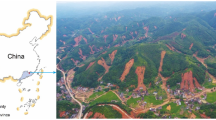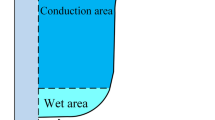Abstract
Affected by typhoons over years, Fujian Province in Southeast China has developed a large number of shallow landslides, causing a long-term concern for the local government. The study on shallow landslide is not only helpful to the local government in disaster prevention, but also the theoretical basis of regional early warning technology. To determine the whole-process characteristics and failure mechanisms of flow-slide failure of granite residual soil slopes, we conducted a detailed hazard investigation in Minqing County, Fujian Province, which was impacted by Typhoon Lupit-induced heavy rainfall in August 2021. Based on the investigation and preliminary analysis results, we conducted indoor artificial rainfall physical model tests and obtained the whole-process characteristics of flow-slide failure of granite residual soil landslides. Under the action of heavy rainfall, a granite residual soil slope experiences initial deformation at the slope toe and exhibits development characteristics of continuous traction deformation toward the middle and upper parts of the slope. The critical volumetric water content during slope failure is approximately 53%. Granite residual soil is in a state of high volumetric water content under heavy rainfall conditions, and the shear strength decreases, resulting in a decrease in stability and finally failure occurrence. The new free face generated after failure constitutes an adverse condition for continued traction deformation and failure. As the soil permeability (cm/h) is less than the rainfall intensity (mm/h), and it is difficult for rainwater to continuously infiltrate in short-term rainfall, the influence depth of heavy rainfall is limited. The load of loose deposits at the slope foot also limits the development of deep deformation and failure. With the continuous effect of heavy rainfall, the surface runoff increases gradually, and the influence mode changes from instability failure caused by rainfall infiltration to erosion and scouring of surface runoff on slope surface. Transportation of loose materials by surface runoff is an important reason for prominent siltation in disaster-prone areas.
Similar content being viewed by others
References
An R, Kong L, Li C, et al. (2020) Strength attenuation and microstructure damage of granite residual soils under hot and rainy weather. Chin J Rock Mech Eng 39(9): 1902–1911. (In Chinese) https://doi.org/10.13722/j.cnki.jrme.2020.0073
Bai H, Feng W, Yi X, et al. (2021) Group-occurring landslides and debris flows caused by the continuous heavy rainfall in June 2019 in Mibei Village, Longchuan County, Guangdong Province, China. Nat Hazards 108(3): 3181–3201. https://doi.org/10.1007/s11069-021-04819-1
Coelho-Netto AL, Avelar AS, Fernandes MC, et al. (2007) Landslide susceptibility in a mountainous geoecosystem, Tijuca Massif, Rio de Janeiro: The role of morphometric subdivision of the terrain. Geomorphology 87(3): 120–131. https://doi.org/10.1016/j.geomorph.2006.03.041
Crosta GB, Dal Negro P (2003) Observations and modelling of soil slip-debris flow initiation processes in pyroclastic deposits: the Sarno 1998 event. Nat Hazard Earth Sys 3(1/2): 53–69. https://doi.org/10.5194/nhess-3-53-2003
Cevasco A, Pepe G, Brandolini P (2014) The influences of geological and land use settings on shallow landslides triggered by an intense rainfall event in a coastal terraced environment. B Eng Geol Environ 73(3): 859–875. https://doi.org/10.1007/s10064-013-0544-x
Coutinho RQ, Silva MM, Santos AND, et al. (2019) Geotechnical Characterization and Failure Mechanism of Landslide in Granite Residual Soil. J Geotech Geoenviron 145(8): 1–16. https://doi.org/10.1061/(ASCE)GT.1943-5606.0002052
da Silva RP, Lacerda WA, Coelho Netto AL (2022) Relevant geological-geotechnical parameters to evaluate the terrain susceptibility for shallow landslides: Nova Friburgo, Rio de Janeiro, Brazil. B Eng Geol Environ 81(1): 1–18. https://doi.org/10.1007/s10064-021-02557-z
Dahal RK, Hasegawa S, Nonomura A, et al. (2009) Failure characteristics of rainfall-induced shallow landslides in granitic terrains of Shikoku Island of Japan. Environ Geol 56(7): 1295–1310. https://doi.org/10.1007/s00254-008-1228-x
Du Q, Zhou J (2020) Centrifugal model tests on slope failure induced by rainfall. Chin J Geotech Eng 42(S1): 50–54. (In Chinese) https://doi.org/10.11779/CJGE2020S1010
Fuchu D, Lee CF, Sijing W (1999) Analysis of rainstorm-induced slide-debris flows on natural terrain of Lantau Island, Hong Kong. Eng Geol 51(4): 279–290. https://doi.org/10.1016/S0013-7952(98)00047-7
Guthrie RH, Evans SG (2004) Analysis of landslide frequencies and characteristics in a natural system, Coastal British Columbia. Earth Surf Proc Land 29(11): 1321–1339. https://doi.org/10.1002/esp.1095
Guo Z, Jian W, Liu Q, et al. (2021) Rainfall infiltration analysis and infiltration model of slope based on in-situ tests. Rock Soil Mech 42(6): 1635–1647. (In Chinese) https://doi.org/10.16285/j.rsm.2020.1557
Hencher SR (2010) Preferential flow paths through soil and rock and their association with landslides. Hydrol process 24(12): 1610–1630. https://doi.org/10.1002/hyp.7721
Hu H, Hu Z, Ruan R (2020) Research on landslide simulated experiment and slope sliding mesoscopic rule of granite residual soil under heavy rainfall. J Xiamen Univ (Nat Sci) 59(04): 583–589. (In Chinese) https://doi.org/10.6043/j.issn.0438-0479.201810023
Hu H, Liang J, Cai L, et al. (2015) Experiment and research on dynamic rheological damage mechanics characteristics and damage degree influence with different moisture content of granite residual soil. J Hydraul Eng 46(S1): 54–58. (In Chinese) https://doi.org/10.13243/j.cnki.slxb.2015.S1.010
Huang B, Qiu M, Lin J, et al. (2019) Correlation between shear strength and soil physicochemical properties of different weathering profiles of the non-eroded and collapsing gully soils in southern China. J Soil Sediment 19(11): 3832–3846. https://doi.org/10.1007/s11368-019-02313-7
Hu H, Wu X, Zhang Y (2021) Failure mode analysis of granite residual soil slope based on rainfall landslide simulation test. J Xiamen Univ (Nat Sci) 60(6): 1098–1102. (In Chinese) https://doi.org/10.6043/j.issn.0438-0479.202004031
Jian W, Huang C, Luo Y, et al. (2020) Experimental study on wetting front migration induced by rainfall infiltration in unsaturated eluvial and residual soil. Rock Soil Mech 41(4): 1123–1133. (In Chinese) https://doi.org/10.16285/j.rsm.2019.0491
Lin H, Yu Y, Li G, et al. (2009) Influence of rainfall characteristics on soil slope failure. Chin J Rock Mech Eng 28(1): 198–204. (In Chinese)
Li X, Liu H, Pan J, et al. (2020) Rainfall thresholds of shallow landslides in Wuyuan County of Jiangxi Province, China. Open Geosci 12(1): 821–831. https://doi.org/10.1515/geo-2020-0120
Liu W, Song X, Huang F, et al. (2019) Experimental study on the disintegration of granite residual soil under the combined influence of wetting-drying cycles and acid rain. Geomat Nat Haz Risk 10(1): 1912–1927. https://doi.org/10.1080/19475705.2019.1651407
Luo X, Gao H, He P, et al. (2021) Experimental investigation of dry density, initial moisture content, and temperature for granite residual soil disintegration. Arab J Geosci 14(11): 1060. https://doi.org/10.1007/s12517-021-07239-4
Liu W, Wan S, Luo X, et al. (2020) Experimental study of suffusion characteristics within granite residual soil controlling inflow velocity. Arab J Geosci 13(22): 1191. https://doi.org/10.1007/s12517-020-06193-x
Liu L, Yin K (2008) Analysis of rainfall infiltration mechanism of rainstorm landslide. Rock Soil Mech 29(4): 1061–1066. (In Chinese) https://doi.org/10.16285/j.rsm.2008.04.005
Pan Y, Jian W, Li L, et al. (2020) A study on the rainfall infiltration of granite residual soil slope with an improved Green-Ampt model. Rock Soil Mech 41(8): 2685–2692. (In Chinese) https://doi.org/10.16285/j.rsm.2019.1734
Park DW, Nikhil NV, Lee SR (2013) Landslide and debris flow susceptibility zonation using TRIGRS for the 2011 Seoul landslide event. Nat Hazard Earth Sys 13(11): 2833–2849. https://doi.org/10.5194/nhess-13-2833-2013
Saffari P, Nie W, Noor MJM, et al. (2019) Characterization the geotechnical properties of a Malaysian granitic residual soil grade V. IOP Conference Series: Earth Env Sci 289: 12006. https://doi.org/10.1088/1755-1315/289/1/012006
Tang L, Sang H, Song J, et al. (2013) Research on soil particle joint function and brittle-elastoplastic cement damage model of unsaturated granite residual soil. Rock Soil Mech 34(10): 2877–2888. (In Chinese) https://doi.org/10.16285/j.rsm.2013.10.015
Tang Y, Zhang M, Xue Q, et al. (2012) Landslide Monitoring and Early-warning: an Overview. Geol Rev 58(3): 533–541. https://doi.org/10.16509/j.georeview.2012.03.016
Wang Z, Zhou Y, Li B, et al. (2020a) Micro-structure and evolution of relict joints and weathered granite soils in the Southeastern Guangxi, China. J Earth Sci Environ 42(3): 405–415. (In Chinese) https://doi.org/10.19814/j.jese.2019.10040
Wang D, Zeng Q, Wang J, et al. (2020b) Effect of Dry-Wet Cycle on Stability of Granite Residual Soil Slope. IOP Conference Series: Earth Env Sci 526: 12046. https://doi.org/10.1088/1755-1315/526/1/012046
Wei X, Fan W, Chai X, et al. (2020) Field and numerical investigations on triggering mechanism in typical rainfall-induced shallow landslides: a case study in the Ren River catchment, China. Nat Hazards 103(2): 2145–2170. https://doi.org/10.1007/s11069-020-04075-9
Wu C, Lin C (2021) Spatiotemporal Hotspots and Decadal Evolution of Extreme Rainfall-Induced Landslides: Case Studies in Southern Taiwan. Water 13(15): 2090. https://doi.org/10.3390/w13152090
Xu X, Jian W, Wu N, et al. (2018) Model test of rainfall-induced residual soil slope failure. China J Highw Transp 31(2): 270–279. (In Chinese) https://doi.org/10.3969/j.issn.1001-7372.2018.02.029
Yan J, Huang J, Li H, et al. (2020) Study on instability mechanism of shallow landslide caused by typhoon and heavy rain. J Geomech 26(4): 481–491. (In Chinese) https://doi.org/10.12090/j.issn.1006-6616.2020.26.04.041
Yang Z, Wang L, Shi L, et al. (2020) Research of monitoring and early warning methods for rainfall-induced landslides based on multivariate thresholds. Chin J Rock Mech Eng 39(2): 272–285. (In Chinese) https://doi.org/10.13722/j.cnki.jrme.2019.0354
Yang H, Yang T, Zhang S, et al. (2020) Rainfall-induced landslides and debris flows in Mengdong Town, Yunnan Province, China. Landslides 17(4): 931–941. https://doi.org/10.1007/s10346-019-01336-y
Zhang S, Tang H (2013) Experimental study of disintegration mechanism for unsaturated granite residual soil. Rock Soil Mech 34(6): 1668–1674. (In Chinese) https://doi.org/10.16285/j.rsm.2013.06.009
Zhang C, Zhang M, Zhang T, et al. (2020) Influence of intrusive granite dyke on rainfall-induced soil slope failure. B Eng Geol Environ 79(10): 5259–5276. https://doi.org/10.1007/s10064-020-01895-8
Acknowledgements
This research was funded by the National Natural Science Foundation of China (Grant Nos. U2005205, 41977252), National Key R&D Program of China (2018YFC1505503), Open Fund of Key Laboratory of Geohazard Prevention of Hilly Mountains, Ministry of Natural Resources (Fujian Key Laboratory of Geohazard Prevention) (FJKLGH2022K001), and the State Key Laboratory of Geohazard Prevention and Geoenvironment Protection Independent Research Project (Grant No. SKLGP2020Z001). In the process of field investigation, Minqing County People’s Government has provided a lot of support to the research group to ensure the smooth completion of field investigation. We would like to express our gratitude here. At the same time, we thank the local residents of Minqing County for the relevant geohazard information provided during the investigation, which provides favorable help for the later experimental model design of the research group.
Author information
Authors and Affiliations
Corresponding author
Rights and permissions
About this article
Cite this article
Bai, Hl., Feng, Wk., Li, Sq. et al. Flow-slide characteristics and failure mechanism of shallow landslides in granite residual soil under heavy rainfall. J. Mt. Sci. 19, 1541–1557 (2022). https://doi.org/10.1007/s11629-022-7315-8
Received:
Revised:
Accepted:
Published:
Issue Date:
DOI: https://doi.org/10.1007/s11629-022-7315-8




